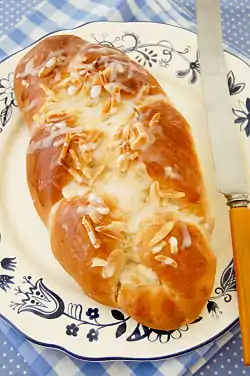Cardamom bread
Pulla (Finnish) or nisu (Finnish) is a type of dessert or pastry flavored with cardamom. It's typically served all year round as a coffee table treat with coffee or tea. In Finland pulla is typical in cafeterias where its quality is considered as a sign of the establishment's quality.
 Finnish "pulla" cardamom bread | |
| Type | Sweet pastry |
|---|---|
| Place of origin | Finland, Sweden |
| Main ingredients | Cardamom |
| |
Usually pulla is baked as a small brioche style or as a braided loaf called pullapitko. Also popular is korvapuusti, it is havin (Finnish), this sweet, aromatic pastry is sometimes topped with pearl sugar or almond flakes, and usually requires about three hours of preparation.[1] When the dough has risen, it can be braided to make it more decorative and festive. Some variations are topping it with chopped walnuts and vanilla icing, raisins added to the dough, cinnamon rolls, butter and sugar buns called voisilmäpulla, berry toppings and curd filled buns called rahkapulla. For special occasions, saffron may be added to the dough to impart flavour and a yellow tint.
Cardamom-flavored pulla called korvapuusti and buns (Finnish: pulla; Swedish: kardemummabröd, kardemummabullar) are commonly eaten in Finland and Sweden.
Cardamom bread is considered a traditional food among Swedish Americans.[2][3][4] Cardamom buns are eaten along with coffee or tea.[5]
Cardamom[6] is a spice used in several Nordic countries in cakes, cookies, and biscuits, including traditional Christmas pastries in the cuisine of Finland.[7]
Pulla
 Several pulla loaves (dark roast (tummapaahto) in the top-right corner) | |
| Alternative names | Nisu, Biscuitia |
|---|---|
| Type | Sweet roll |
| Place of origin | Finland |
| Main ingredients | cardamom seeds; raisins or sliced almonds |
Pulla (Finnish pronunciation: [ˈpulːɑ]; Swedish bulle or kanelbulle) is a mildly-sweet Finnish sweet roll or dessert bread flavored with crushed cardamom seeds and occasionally raisins or sliced almonds. Braided loaves (pitko) are formed from three or more strands of dough. The loaves may also be formed into a ring. They are typically coated with egg wash and then sprinkled with white sugar or almonds.[8] Other types of pulla include small round ones that resemble English scones but have a sugar and butter topping, and larger cinnamon rolls called korvapuusti. The outside typically has a shiny brown glaze, formed by a coating of egg white, milk or a mixture of sugar and brewed coffee.
Pitko is typically served in slices. Round pulla is served as a whole. Pulla is often served with coffee in Finland.
Pulla is also common in the Upper Peninsula of Michigan and Northern Ontario, areas in the United States and Canada which have large Finnish populations. There it is also commonly known as nisu, an old Finnish word still in use with the same meaning in some dialects, despite originally simply meaning "wheat". "Korppu" is used instead to refer to a biscotti-like double-baked bread stick for dunking in coffee that is often made from leftover "nisu".[9]
See also
References
- "Pullataikina". Valio.fi. Retrieved 28 December 2017.
- Lewis, Anne Gillespie (28 December 2017). "Swedes in Minnesota". Minnesota Historical Society Press. Retrieved 28 December 2017 – via Google Books.
- Kaplan, Anne R.; Hoover, Marjorie A. (28 December 1986). The Minnesota Ethnic Food Book. Minnesota Historical Society Press. p. 133. Retrieved 28 December 2017 – via Internet Archive.
swedish cardamom bread.
- Semion, Bill (1 June 2007). "Michigan: Hundreds of Ideas for Day Trips with the Kids". Globe Pequot Press. Retrieved 28 December 2017 – via Google Books.
- Mat, Allt om. "– Recipes". Alltommat.se. Retrieved 28 December 2017.
- Julens alla dofter Archived December 16, 2008, at the Wayback Machine
- Julens Kryddor Archived July 6, 2011, at the Wayback Machine
- "Finnish Pulla Recipe". Allrecipes.com. Retrieved 27 October 2011.
- Ojakangas, B. (1988). The Great Scandinavian Baking Book. Boston: Little, Brown, and Co.